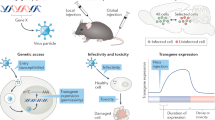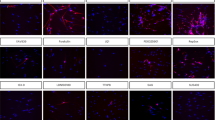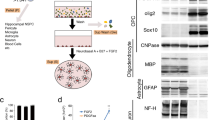Abstract
Neurotrophic factors (NTFs) are known to govern the processes involved in central nervous system cell proliferation and differentiation. Thus, they represent very attractive candidates for use in the study and therapy of neurological disorders. We constructed recombinant herpesvirus-based-vectors capable of expressing fibroblast growth factor-2 (FGF-2) and ciliary neurotrophic factor (CNTF) alone or in combinations. In vitro, vectors expressing FGF-2 and CNTF together, but not those expressing either NTF alone, caused proliferation of O-2A progenitors. Furthermore, based on double-labeling experiments performed using markers for neurons (MAP-2), oligodendrocytes (CNPase) and astrocytes (GFAP), most of the new cells were identified as astrocytes, but many expressed neuronal or oligodendrocytic markers. In vivo, vectors have been injected in the rat hippocampus. At 1 month after inoculation, a highly significant increase in BrdU-positive cells was observed in the dentate gyrus of animals injected with the vector expressing FGF-2 and CNTF together, but not in those injected with vectors expressing the single NTFs. Furthermore, double-labeling experiments confirmed in vitro data, that is, most of the new cells identified as astrocytes, some as neurons or oligodendrocytes. These data show the feasibility of the vector approach to induce proliferation and differentiation of neurons and/or oligodendrocytes in vivo.
This is a preview of subscription content, access via your institution
Access options
Subscribe to this journal
Receive 12 print issues and online access
$259.00 per year
only $21.58 per issue
Buy this article
- Purchase on Springer Link
- Instant access to full article PDF
Prices may be subject to local taxes which are calculated during checkout








Similar content being viewed by others
References
Bjorklund A, Lindvall O . Cell replacement therapies for central nervous system disorders. Nat Neurosci 2000; 3: 537–544.
Gross CG . Neurogenesis in the adult brain: death of a dogma. Nat Rev Neurosci 2000; 1: 67–73.
Temple S . The development of neural stem cells. Nature 2001; 414: 112–117.
Gage FH . Mammalian neural stem cells. Science 2000; 25: 1433–1438.
Thoenen H, Sendtner M . Neurotrophins: from enthusiastic expectations through sobering experiences to rational therapeutic approaches. Nat Neurosci 2002; 5 (Suppl): 1046–1050.
Cameron HA, McKay R . Stem cells and neurogenesis in the adult brain. Curr Opin Neurobiol 1998; 8: 677–680.
Nakatomi H et al. Regeneration of hippocampal pyramidal neurons after ischemic brain injury by recruitment of endogenous neural progenitors. Cell 2002; 110: 429–441.
Song MR, Ghosh A . FGF2-induced chromatin remodeling regulates CNTF-mediated gene expression and astrocyte differentiation. Nat Neurosci 2004; 7: 229–235.
Lipton P . Ischemic cell death in brain neurons. Physiol Rev 1999; 79: 1431–1568.
Sutula TP, Hagen J, Pitkanen A . Do epileptic seizures damage the brain? Curr Opin Neurol 2003; 16: 189–195.
Rietze R, Poulin P, Weiss S . Mitotically active cells that generate neurons and astrocytes are present in multiple regions of the adult mouse hippocampus. J Comp Neurol 2000; 424: 397–408.
Simonato M, Manservigi R, Marconi P, Glorioso J . Gene transfer into neurones for the molecular analysis of behaviour: focus on herpes simplex vectors. Trends Neurosci 2000; 23: 183–190.
Krisky DM et al. Development of herpes simplex virus replication-defective multigene vectors for combination gene therapy applications. Gene Therapy 1998; 5: 1517–1530.
Krisky DM et al. Deletion of multiple immediate-early genes from herpes simplex virus reduces cytotoxicity and permits long-term gene expression in neurons. Gene Therapy 1998; 5: 1593–1603.
Marconi P et al. Replication-defective herpes simplex virus vectors for gene transfer in vivo. Proc Natl Acad Sci USA 1996; 93: 11319–11320.
Palmer TD et al. Fibroblast growth factor-2 activates a latent neurogenic program in neural stem cells from diverse regions of the adult CNS. J Neurosci 1999; 19: 8487–8497.
Qian X, Davis AA, Goderie SK, Temple S . FGF2 concentration regulates the generation of neurons and glia from multipotent cortical stem cells. Neuron 1997; 18: 81–93.
Morrow T, Song MR, Ghosh A . Sequential specification of neurons and glia by developmentally regulated extracellular factors. Development 2001; 128: 3585–3594.
Lillien LE, Raff MC . Differentiation signals in the CNS: type-2 astrocyte development in vitro as a model system. Neuron 1990; 5: 111–119.
Louis JC, Magal E, Takayama S, Varon S . CNTF protection of oligodendrocytes against natural and tumor necrosis factor-induced death. Science 1993; 259: 689–692.
Hermanson O, Jepsen K, Rosenfeld MG . N-CoR controls differentiation of neural stem cells into astrocytes. Nature 2002; 419: 934–939.
Hanson MG et al. Cyclic AMP elevation is sufficient to promote the survival of spinal motor neurons in vitro. J Neurosci 1998; 18: 7361–7371.
Ip NY et al. CNTF, FGF, and NGF collaborate to drive the terminal differentiation of MAH cells into postmitotic neurons. Neuron 1994; 13: 443–455.
Marmur R et al. Differentiation of oligodendroglial progenitors derived from cortical multipotent cells requires extrinsic signals including activation of gp130/LIFbeta receptors. J Neurosci 1998; 18: 9800–9811.
Murata T et al. Temperature-dependent, neurotrophic factor-elicited, neuronal differentiation in adrenal chromaffin cell line immortalized with temperature-sensitive SV40 T-antigen. J Neurochem 2003; 85: 1126–1138.
Murphy P et al. The regulation of Krox-20 expression reveals important steps in the control of peripheral glial cell development. Development 1996; 122: 2847–2857.
Rabinovsky ED, Ramchatesingh J, McManaman JL . Regulation of tyrosine hydroxylase gene expression in IMR-32 neuroblastoma cells by basic fibroblast growth factor and ciliary neurotrophic factor. J Neurochem 1995; 64: 2404–2412.
Simonato M et al. Effects of defective herpes simplex vectors expressing neurotrophic factors on the proliferation and differentiation of nervous cells in vivo. Society Neuroscience Abstracts 2002; 789: 18.
Wu N, Watkins SC, Schaffer PA, DeLuca NA . Prolonged gene expression and cell survival after infection by a herpes simplex virus mutant defective in the immediate-early genes encoding ICP4, ICP27 and ICP22. J Virol 1996; 70: 6358–6369.
Marconi P et al. Replication-defective herpes simplex virus vectors for neurotrophic factor gene transfer in vitro and in vivo. Gene Therapy 1999; 6: 904–912.
Avellana-Adalid V, Nait-Oumesmar B, Lachapelle F, Baron-Van Evercooren A . Expansion of rat oligodendrocyte progenitors into proliferative ‘oligospheres’ that retain differentiation potential. J Neurosci Res 1996; 45: 558–570.
Lubetzki C et al. Morphological, biochemical, and functional characterization of bulk isolated glial progenitor cells. J Neurochem 1991; 56: 671–680.
Maric D et al. Anatomical gradients in proliferation and differentiation of embryonic rat CNS accessed by buoyant density fractionation: α3, β3 and γ2 GABA A receptor subunit co-expression by post-mitotic neocortical neurons correlates directly with cell buoyancy. Eur J Neurosci 1997; 9: 507–522.
Gall C, Berschauer R, Isackson PJ . Seizures increase basic fibroblast growth factor mRNA in adult forebrain neurons and glia. Mol Brain Res 1994; 21: 190–205.
Henderson JT, Seniuk NA, Roder JC . Localization of CNTF immunoreactivity to neurons and astroglia in the CNS. Mol Brain Res 1994; 22: 151–165.
Arvidsson A et al. Neuronal replacement from endogenous precursors in the adult brain after stroke. Nat Med 2002; 8: 963–970.
Jankowsky JL, Patterson PH . The role of cytokines and growth factors in seizures and their sequelae. Prog Neurobiol 2001; 63: 125–149.
Glorioso JC, Mata M, Fink DJ . Therapeutic gene transfer to the nervous system using viral vectors. J Neurovirol 2003; 9: 165–172.
Krisky DM et al. Rapid method for construction of recombinant HSV gene transfer vectors. Gene Therapy 1997; 4: 1120–1125.
Krisky D, Marconi P, Goins WF, Glorioso JC . Development of replication-defective herpes simplex virus vectors. In: Robbins P (ed). Molecular Medicine, Gene Therapy Protocols. Humana Press Inc.: Totowa, NJ, 1996.
Pertoft H, Laurent TC . Isopycnic separation of cells by centrifugation in Percoll gradients. Prog Clin Biol Res 1982; 102: 95–104.
Pellegrino LJ, Pellegrino AS, Cushman AJ . A Stereotaxic Atlas of the Rat Brain. Plenum Press: New York, 1979.
Acknowledgements
This work has been supported by grants from Telethon (E.0954), the Italian Ministry for the University and Scientific Research (FISR), the Italian National Institute of Health (Program Stem Cells, CS 126.1) and the Italian Association for Cancer Research (AIRC). We thank Chiara Zerbini, Luca Boccafogli, Gianluca Gardo, Federica Vasquez, Eros Magri, Daniela Nardo and Fernanda Mora for technical assistance.
Author information
Authors and Affiliations
Rights and permissions
About this article
Cite this article
Marconi, P., Zucchini, S., Berto, E. et al. Effects of defective herpes simplex vectors expressing neurotrophic factors on the proliferation and differentiation of nervous cells in vivo. Gene Ther 12, 559–569 (2005). https://doi.org/10.1038/sj.gt.3302438
Received:
Accepted:
Published:
Issue Date:
DOI: https://doi.org/10.1038/sj.gt.3302438
Keywords
This article is cited by
-
Development and application of replication-incompetent HSV-1-based vectors
Gene Therapy (2005)



